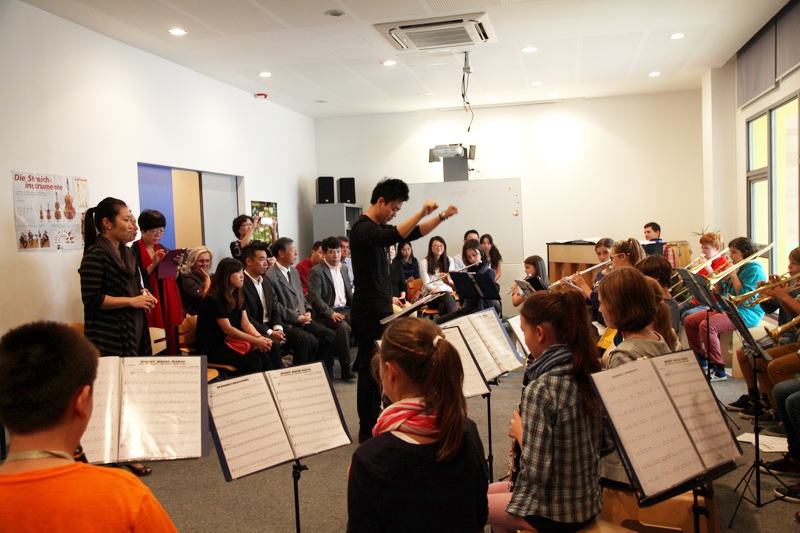CMIA and CAFIM address musical education issues
China Association of Musical Instruments (CMIA) und Confederation of European Music Industries (CAFIM) assemble for lesson-attendance session at German School in Shanghai/Pudong applying “Music-in-the-Classroom” methods using musical instruments
With musical education coming to assume an important issue of talks conducted in regular intervals by European and Chinese musical instrument manufacturers associations, time had come round for general-information sharing on this subject to be followed by a practical approach.CMIA und CAFIM befassen sich mit „Musikerziehung”
Unterrichtsbesuch an der Deutschen Schule in Shanghai Pudong zum „KlassenMusizieren“ mit Musikinstrumenten der Delegierten des chinesischen Verbandes der Musikwirtschaft, China Association of Musical Instruments (CMIA) und des europäischen, Conföderation der Europäischen Musikindustrien (CAFIM)
In den regelmäßig stattfindenden Gesprächen zwischen dem europäischen und chinesischen Verband der Musikwirtschaft bildet Musikerziehung zunehmend einen Schwerpunkt. Dem allgemeinen Informationsaustausch zum Thema sollten praktische Beispiele folgen.
 Legend: Visit at the German School in Pudong “Music in the classroom”; Delegation of CMIA and CAFIM in the background Legend: Visit at the German School in Pudong “Music in the classroom”; Delegation of CMIA and CAFIM in the background |
For some years now, the German School located in the Pudong district of Shanghai, not far from the trade-fair grounds where the annual “Music China” expo takes place, has been successfully applying the “Music-in-the-Classroom” concept evolved by the Music Education Academy in Wiesbaden (Germany) and supported by the National Association of German Musical Instruments Manufacturers (BDMH). Developed by music educators for music educators, this method is used for collective instrumental musical instruction at normal state-run schools providing general education and is employed for teaching wind, bowed and percussion instruments. In Pudong, wind-instrument tuition is provided group-wise. Accordingly, it made sense for both organizations that traditionally meet for talks within the scope of the Music China event, to assemble there for a lesson-attendance session. This also afforded a good opportunity for colleagues from CAFIM member countries to acquaint themselves with musical education presented in this format. In Germany, where the “Music-in-the-Classroom” concept was introduced in 1987, this form of teaching has had a tremendous impact on boosting instrument sales. Many youngsters taught to play an instrument in this way have at least continued to pursue music as a pastime if not professionally, thus permanently enhancing business in the music branch, true to the popular slogan: “Make more music makers“!
All participating in the lesson attendance went away highly impressed by the tuition method as well as by the congenial atmosphere and enthusiasm radiating from pupils and teachers alike. Tuition is provided by a music teacher from Germany, previously trained at the Music Education Academy, in conjunction with two Chinese colleagues, one of whom studied in Germany. Collective instruction is given to the children on at least three school days a week, complemented by tuition on a one-to-one basis. Accordingly, significant learning progress becomes palpable within a short space of time.
Obviously stimulated by the impressive lesson-attendance session, the CMIA has now put forth a proposal aimed at arranging further guest visits for delegates responsible for musical education in China at normal day schools providing a general curriculum and displaying an interest in the concept.
In 2014, it is planned to hold a seminar on music tuition combined with teacher in-service training geared to the “Music-in-the-Classroom” method centrally within the ‘Music China’ fair complex with the objective of presenting what has been so successfully implemented in Germany to other interested users on a broader scale. This would definitely endorse the aims pursued by the organizers of the Frankfurt Music Fair, who have continued to provide financial assistance and sponsorship to the Academy in support of the “Music-in-the-Classroom” concept for so many years.
As a school subject, music has come to qualify for increasing significance, not least on account of growing public awareness of the need through “Music-in-the-Classroom” teaching ideas. This method generates additional incentive for shared musical activity beyond normal class tuition. Schools not only make their premises and tutors available, they also propagate the initiative of making music together, thus contributing to upholding instrumental tuition, an aspect of vital importance not to be underestimated! The wealth of given opportunity to perform to audiences, enhanced by involvement in joint activity, all inspired by the “Music-in-the-Classroom” impetus, serves to promote individuality while strengthening cooperation within the group. It is always gratifying to observe increasing numbers of pupils taught applying the “Music-in-the-Classroom” concept developing amazing skills in other subjects beyond the realms of music.
 Bildlegende: Schüler der Deutschen Schule Pudong während der Unterrichts- Bildlegende: Schüler der Deutschen Schule Pudong während der Unterrichts-
präsentation; im Hintergrund die Delegierten von CMIA und CAFIM |
Seit einigen Jahren wird das an der Akademie für Musikpädagogik in Wiesbaden, getragen vom Bundesverband der deutschen Musikinstrumenten-Hersteller, von Musikpädagogen für Musikpädagogen entwickelte Programm „KlassenMusizieren“, d.h. Musikerziehung mit Musikinstrumenten im Regelunterricht an allgemein bildenden Schulen, von der Deutschen Schule in Shanghai Pudong, nicht weit vom Messegelände, auf dem alljährlich die ‚Music China‘ stattfindet, eingesetzt. „KlassenMusizieren“ gibt es in den Varianten mit Blas-, Streich- und Perkussionsinstrumenten. In Pudong wird es mit Blasinstrumenten in Form von „Bläserklassen“ angeboten. Da lag es nahe, da man sich ohnehin im Vorfeld der Messe Music China mittlerweile schon traditionell zu Gesprächen verabredet, einen Unterrichtsbesuch abzustatten. Somit hatten auch die Kollegen aus den europäischen Mitgliedsländern der CAFIM die Gelegenheit, dieses Format der Musikerziehung kennenzulernen. In Deutschland hat „KlassenMusizieren“, seit 1987 eingeführt, den Absatz von Musikinstrumenten erheblich stimuliert. Zahlreiche Schüler sind beim Instrument geblieben, zumindest als Hobbymusiker, etc., d.h. zahlreiche neue Kunden haben den Musikmarkt dauerhaft bereichert, ganz im Sinne des bekannten Slogans: “Make more music makers“!
Die Teilnehmer zeigten sich beeindruckt von der Art des Unterrichts, der angenehmen Atmosphäre und der Begeisterung von Schülern wie Lehrern. Ein Musiklehrer aus Deutschland, der an der Fortbildung an der Akademie für Musikpädagogik teilgenommen hat und zwei chinesische Kollegen, von denen einer in Deutschland studiert hat, unterrichten die Kinder an mindestens drei Schultagen gemeinsam; auch findet ergänzend Einzelunterricht statt, so dass bereits nach kurzer Zeit beachtliche Lernfortschritte festzustellen sind.
Beeindruckt vom Besuch des Musikunterrichts mit Musikinstrumenten soll auf Vorschlag von CMIA versucht werden, weitere Unterrichtshospitationen für interessierte Vertreter der Organisationen der Musikerziehung in China an allgemein bildenden Schulen, anzubieten.
Ferner ist geplant, im kommenden Jahr, 2014, auf dem Gelände der ‚Music China‘, zentral für alle Interessenten, ein Seminar zu Musikunterricht und Lehrerfortbildung „KlassenMusizieren“ anzubieten, um dieses in Deutschland so erfolgreich praktizierte Modell einem größeren Kreis vorzustellen. Dies dürfte ganz im Sinne des Veranstalters, der Messe Frankfurt, sein, die seit Jahren die Akademie und damit die Programme des „KlassenMusizierens“ finanziell unterstützt, d.h. sponsert.
Das Fach Musik genießt, nicht zuletzt wegen der Wahrnehmung des „KlassenMusizierens“ in der Öffentlichkeit eine ständig wachsende Bedeutung. Über den regulären Klassenunterricht hinaus entstehen viele Angebote zum gemeinsamen Musizieren. Die Schulen stellen dazu nicht nur Räume und betreuende Lehrkräfte zur Verfügung, sondern vermitteln auch, dass es ganz wichtig ist, gemeinsam zu musizieren, d.h. Instrumentalunterricht zu erhalten. Dadurch ergeben sich u.a. vielfältige Auftrittsmöglichkeiten. Bei diesen gemeinsamen Aktivitäten, hervorgerufen durch den Einsatz des „KlassenMusizierens“ im Regelunterricht, wird so jeder Einzelne gefördert und gleichzeitig die Gemeinschaft gestärkt. Erfreulicherweise können Schüler und Schülerinnen, die nach der Methode des „KlassenMusizierens“ unterrichtet werden, immer wieder erstaunliche Leistungen, nicht nur im Fach Musik, erzielen.
